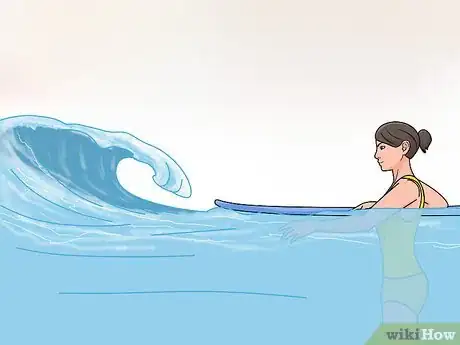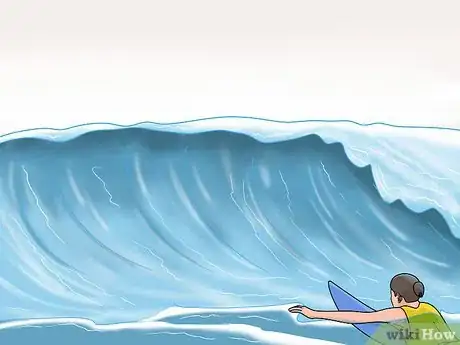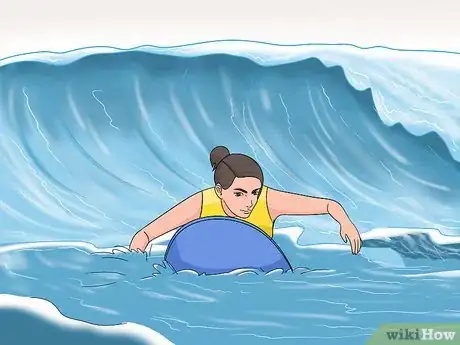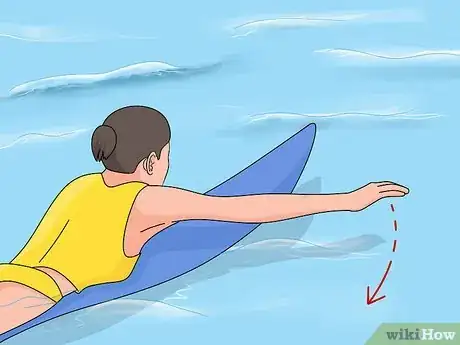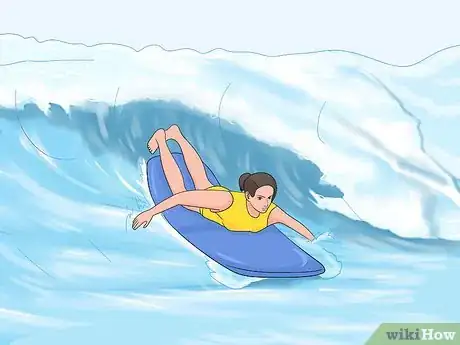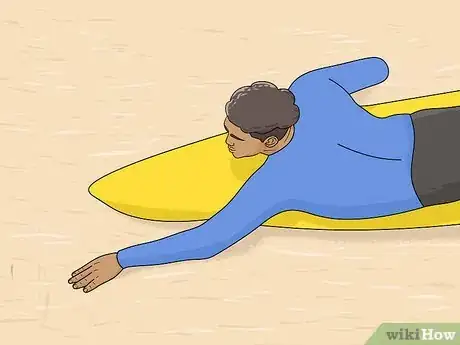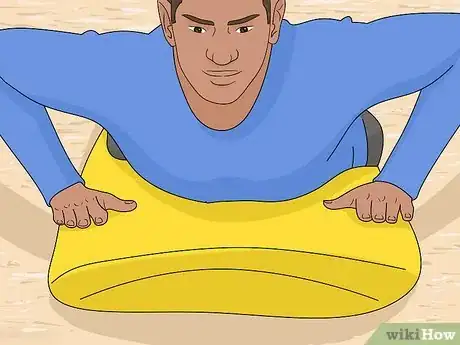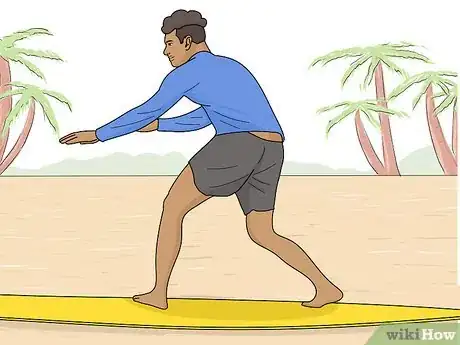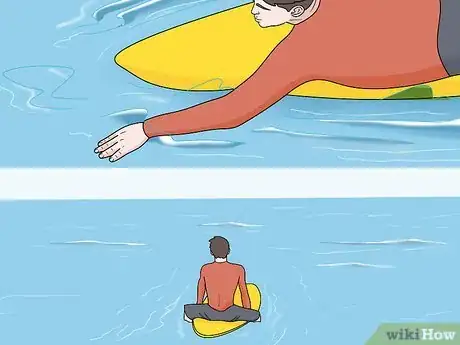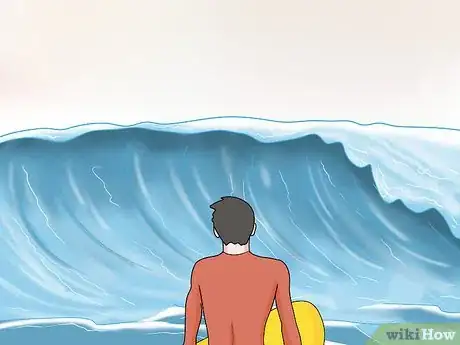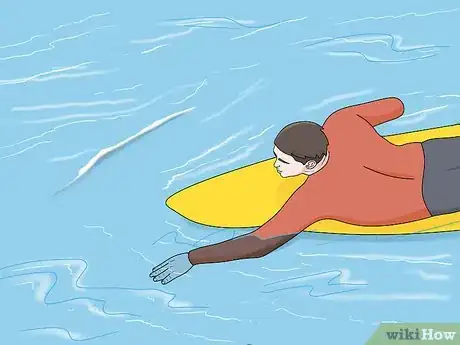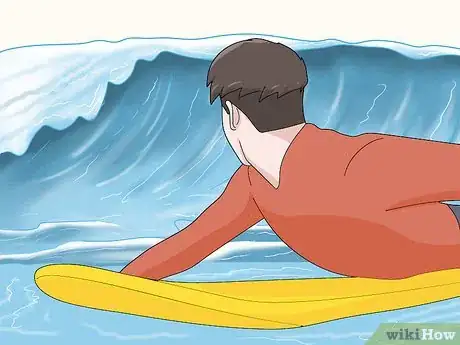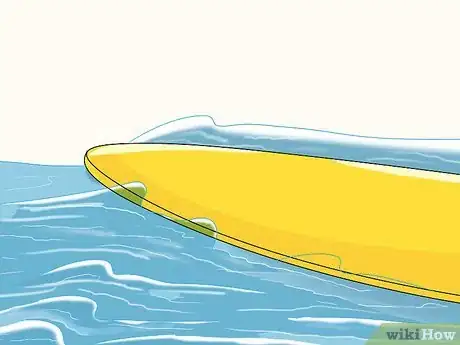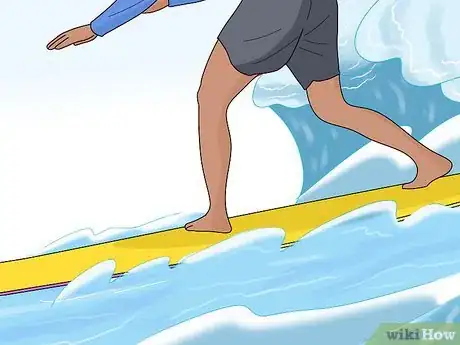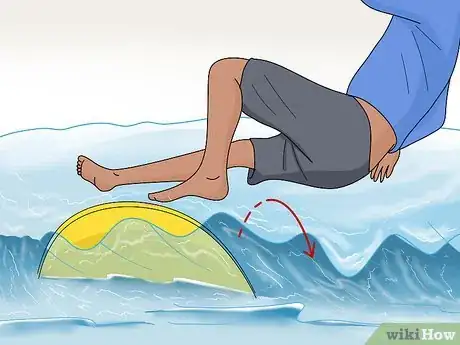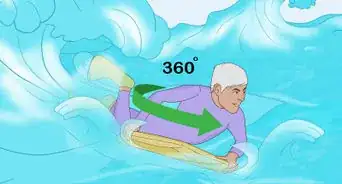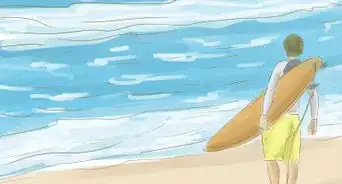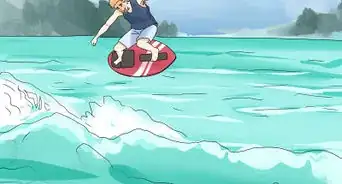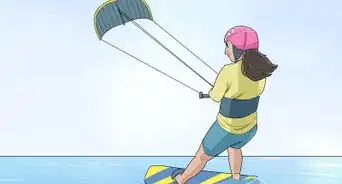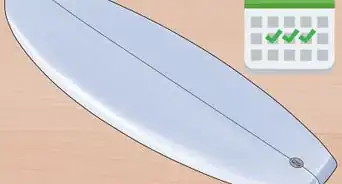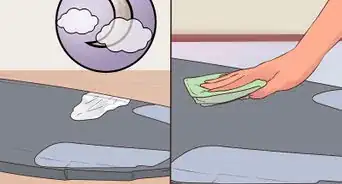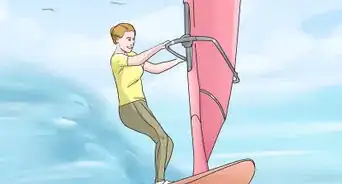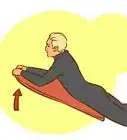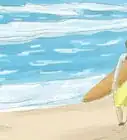This article was co-authored by wikiHow staff writer, Christopher M. Osborne, PhD. Christopher Osborne has been a wikiHow Content Creator since 2015. He is also a historian who holds a PhD from The University of Notre Dame and has taught at universities in and around Pittsburgh, PA. His scholarly publications and presentations focus on his research interests in early American history, but Chris also enjoys the challenges and rewards of writing wikiHow articles on a wide range of subjects.
This article has been viewed 66,792 times.
Learn more...
There are few things in life more thrilling than conquering a big wave on your surfboard—and you too can achieve that feeling with some practice and patience! Start by getting a feel for riding in waves on your belly and mastering “popping up” onto your board while on the beach. After that, head out into the water and work on picking out, catching, and surfing in on an awesome wave!
Steps
Riding Breaking Waves on Your Belly
-
1Wade out to chest-high water where smaller waves are breaking. Hold your board securely in both hands, but off to one side. Otherwise, a breaking wave might smash the board into your face! Stop in an area where you can still touch bottom with your feet. Face away from shore with your board still in both hands and to your side.[1]
- As a novice, wait for ideal conditions to practice. In this case, look for small-ish waves that are breaking consistently in an area where you can touch bottom with both feet.
- Some surf instructions like to start on the sand, while others begin their lessons in shallow water. If you’d prefer to learn your “pop-ups” on the beach first, that’s fine. But you should practice riding waves in on your belly before you try surfing them in standing up.
-
2Pick out a wave that looks like it’ll break on you. You don’t have to be too choosy about waves at this stage. Just look for one that appears like it will break on top of you. Aim to choose it when it’s still about 5–7 m (16–23 ft) away.[2]
- While you’re waiting, use your board to help you bob up and over waves that are breaking closer to shore. If a wave unexpectedly breaks on you, use your board to help you dive under and through it.
Advertisement -
3Push off toward the shore and onto your board. When your chosen wave is 5 m (16 ft) away, turn your body toward the shore and push off the ocean floor forcefully with your feet. Use this push-off to help lift yourself up onto your board. Try to land with your body weight centered on the board, your hands to the sides of your pectorals, and your feet at the tail end (but not over the edge) of the board.[3]
- It will take a few tries to get this push-off, turn, and hop-on combination right—but stick with it! Sure, you’ll get bowled over by a few waves in the process, but keep trying!
-
4Paddle with long, deep strokes until the wave takes you. Resist the urge to make fast, shallow, and weak paddling motions with your arms. Instead, focus on thrusting your arms deep into the water and driving them back and around forcefully. Try to match the speed of the wave, and keep paddling until the breaking wave is clearly propelling you forward.[4]
- One good rule of thumb for beginners is to take 2 more good paddle strokes than you think you need—in other words, paddle 2 more times after you think the wave has picked you up.
- When you’re ready to hop up on your board and surf, you’ll want to look back at the wave while paddling with your arms. At this point, however, just look towards the shore and focus on paddling forcefully.
-
5Adjust your positioning if you’re missing the waves. If the waves keep passing you by instead of picking you up and propelling you to shore, there are 3 likely adjustments to make. First, move a little further up on the board to keep the nose down toward the water line. Second, paddle harder! Third, try moving a bit closer to shore to catch the waves right where they’re breaking.[5]
- Alternatively, if you keep getting bowled over by the waves—known as “pearling” in surfing terms—make the opposite adjustments: move back a bit on the board, paddle ever-so-slightly less forcefully, and move a little farther away from shore.
Mastering Pop-Ups on the Sand
-
1Lie centered on your board with good hand and foot positioning. Practice putting your breastbone right over the center line of the board. Put your arms out to your sides at about chest height (since you can’t paddle in the sand!) and place your toes on the tail end of the board—not over the edge.[6]
- Keep your body down on the board, but lift your head up as if you have a volleyball or soccer ball resting under your chin.
-
2Plant your hands onto the board beside your pectorals. The main thrust for a good pop-up comes from your arms, so you need to provide a firm base with your hands. press your palms flat onto the board and let your fingers curl just enough over the edges to provide stability. Your hands should be about even with your pectoral muscles.[7]
- This is essentially the position you want to take in order to do a proper push-up.
-
3Arch your upper body forward and upward. Immediately after planting your hands, begin your lift by raising your upper body. Keep your lower body down on the board while bending your upper body skyward. Your chest should thrust forward in the process.[8]
- The entire process moves very quickly here. Once you get the hang of it, these several steps will become a single, well-choreographed motion.
-
4Thrust upward with your hands and feet. Continue the motion of your upper body arch by pressing down forcefully on the board with both hands and both feet. You need to lift your body high enough to be able to slip your feet underneath you and onto the center of the board.[9]
- Don’t worry if you fall on your face a few times—the sand makes a soft landing spot!
- If anyone ever tries to tell you that surfers aren’t athletes, ask them to pop up on a board on the beach. It requires good upper- and lower-body strength.
-
5Twist your lower body so your feet land along the center line. As you tuck your feet under your raised body, twist your lower half so that your dominant foot (your right foot if you’re right-handed) is closer to the front of the board. Ideally, both feet should land on the center line of the board, pointed nearly perpendicular to its nose (a slight forward angle is okay). They should also be shoulder-width apart to create a solid base.[10]
- Keep your upper body pointed forward as much as possible as you twist your lower body.
- Try to land so that your center of gravity is directly over the center of the board.
- This takes practice, more practice, and—you guessed it—even more practice. But stick with it! And consider taking a lesson with a surf instructor if you aren’t doing so already!
-
6Bend your knees, lean forward, and balance with your arms. Squat down just a little in order to lower your center of gravity. Even though you don’t need to do so on the beach, practice leaning forward to keep your balance as a wave lifts and pushes you.[11]
- Stick your arms to your sides, somewhere between your hips and ribs, with your elbows slightly bent and palms open and pointed down.
- Keep your head up and looking forward. This will be a must when you’re riding a wave!
Catching and Surfing a Wave
-
1Paddle out and sit on your board just beyond the breakers. Walk out with your board to your side until the water is chest-high, then climb on and use your arms to paddle out until you’re about 5 m (16 ft) past where the waves are breaking. Once you get there, sit up on your board with your legs straddling the sides and look out at the oncoming waves.[12]
- If you want, you can slide back on your board and kick with your legs while you’re paddling out.
-
2Pick out a wave that looks like it will break shortly after passing you. Watch the waves for a couple of minutes to get a feel for how they look before they break. Watch for an above-average sized wave that looks like it will break about 5 m (16 ft) after it passes your current position.[13]
- Surfers call this a “green wave”—one that’s ripe for the picking!
-
3Lie down centered on your board, turn, and paddle strongly. As soon as you pick out your wave, drop back down on your board with your body centered, your arms to your sides, and your toes up on the tail end. Paddle with one arm only to turn the board towards the shore, then use both arms to pick up speed.[14]
- Remember to use deep, long paddle strokes, not shallow, short ones. Drive your arms through the water!
-
4Watch the wave over your shoulder so you can match its speed. This takes some practice, but it makes it much easier to catch the wave. Keep your board and body pointed toward the shore, but crane your neck to one side so you can see the oncoming “green wave.” Aim to match the wave’s speed just as it’s getting ready to break.[15]
- Keep paddling hard! The more forward momentum you have, the easier it is to catch the wave instead of having it pass you by or “pearl” you under the water.
-
5Keep the nose of your board just above the water line. Novice surfers tend to let the nose of their board lift high up out of the water as they paddle to catch a wave. Instead, work on keeping the nose about 5 cm (2.0 in) above the water line. Just like everything related to surfing, practice makes perfect![16]
- If your board’s nose is too high, the wave is more likely to pass you by.
-
6Pop up onto your board just as you feel the wave taking you. This last part of catching a wave is all about feel, so it takes time, practice, and patience. As soon as you feel like the wave is lifting the board’s tail and propelling you forward on its own, stop paddling, turn your head toward the shore, and do one of those perfect pop-ups you mastered on the beach![17]
- As a beginner, you’ll wipe out at least a few times, and probably many times, while trying to pop up on the board. But keep at it—the thrill you get the first time you successfully pop up and surf a wave is worth it!
-
7Balance with your arms and legs and surf towards the shore. Just like you practiced on the beach, stay in a partial crouch, lean slightly forward, and keep your arms slightly bent and to your sides. Adjust your center of gravity slightly as needed to maintain your balance. Especially as a novice, follow the wave's lead and head in towards the shore rather than trying to turn against the flow of the wave.[18]
- Mastering turns will let you ride waves longer and more effectively, but save that for later, once you've gained experience riding waves straight in.
-
8Hop off (or fall off) the board to the side and protect your head. If you manage to ride the wave in until you lose forward momentum, congratulations! If you're in shallow water when the board slows enough that you can't keep your balance, jump to the side of the board and land on your feet. If you're still in deeper water, jump to the side and land on your side with your elbows to either side of your head.[19]
- If you know you're about to wipe out while riding the wave, do your best to fall to one side or the other of the board. Try to land on your side and put your arms up to protect your head. Don't fall forward over the front of the board, as this is the kind of fall that's most likely to cause injury.
- Some beginners use a rigid foam surfboard for safety, and you may also consider using protective headgear.
Community Q&A
-
QuestionDo I go over a wave or under it when paddling out to surf a wave?
 Community AnswerUsually you go under the wave in order to get out. It helps you go faster in a shorter time and stops you from getting pulled back.
Community AnswerUsually you go under the wave in order to get out. It helps you go faster in a shorter time and stops you from getting pulled back. -
QuestionWhat is a barreling wave?
 Community AnswerThis is the tube, the hollow part of a wave when it is breaking, and one of the most sought-after things in surfing.
Community AnswerThis is the tube, the hollow part of a wave when it is breaking, and one of the most sought-after things in surfing. -
QuestionHow do I surf a wave in line with the barrel?
 Raphy HongCommunity AnswerIf you're not going in, you can just ride normally. If you want to ride in the barrel, you can turn a little and try to glide through the barrel.
Raphy HongCommunity AnswerIf you're not going in, you can just ride normally. If you want to ride in the barrel, you can turn a little and try to glide through the barrel.
Warnings
- Keep your board (and your body) out of the impact zone of a barreling wave. It's best to avoid barreling waves altogether until you've gained more surfing experience.⧼thumbs_response⧽
- Know your limits and stay within them. Don't try to surf big waves before you're ready for them.⧼thumbs_response⧽
- Make sure there are no natural obstructions (like boulders) or man-made dangers (like old pier pilings) in the area. Reef breaks and shore breaks can also be dangerous.⧼thumbs_response⧽
- Don't learn how to surf in crowded areas. Instead, find an uncrowded area away from experienced surfers and other beach-goers. (This is for safety, not because you should feel embarrassed!)⧼thumbs_response⧽
References
- ↑ https://surfing-waves.com/surfing_lesson_one.htm
- ↑ https://surfing-waves.com/surfing_lesson_one.htm
- ↑ https://surfing-waves.com/surfing_lesson_one.htm
- ↑ https://www.surfertoday.com/surfing/how-to-catch-a-wave-in-surfing
- ↑ https://www.surfertoday.com/surfing/how-to-catch-a-wave-in-surfing
- ↑ https://www.surfertoday.com/surfing/how-to-pop-up-fast-on-a-surfboard
- ↑ https://barefootsurftravel.com/livemore-magazine/find-catch-unbroken-waves-2
- ↑ https://barefootsurftravel.com/livemore-magazine/find-catch-unbroken-waves-2
- ↑ https://www.surfertoday.com/surfing/how-to-pop-up-fast-on-a-surfboard
- ↑ https://www.surfertoday.com/surfing/how-to-pop-up-fast-on-a-surfboard
- ↑ https://www.surfertoday.com/surfing/how-to-pop-up-fast-on-a-surfboard
- ↑ https://barefootsurftravel.com/livemore-magazine/find-catch-unbroken-waves-2
- ↑ https://barefootsurftravel.com/livemore-magazine/find-catch-unbroken-waves-2
- ↑ https://www.surfertoday.com/surfing/how-to-catch-a-wave-in-surfing
- ↑ https://www.surfertoday.com/surfing/how-to-catch-a-wave-in-surfing
- ↑ https://barefootsurftravel.com/livemore-magazine/find-catch-unbroken-waves-2
- ↑ https://barefootsurftravel.com/livemore-magazine/find-catch-unbroken-waves-2
- ↑ https://www.surfertoday.com/surfing/the-basic-tips-for-beginner-surfers
- ↑ https://www.surfertoday.com/surfing/the-basic-tips-for-beginner-surfers
